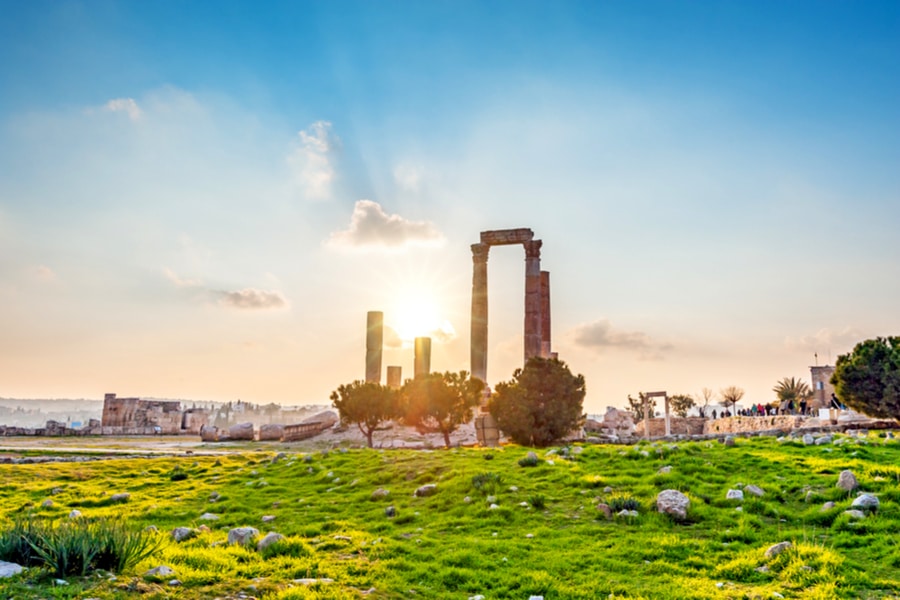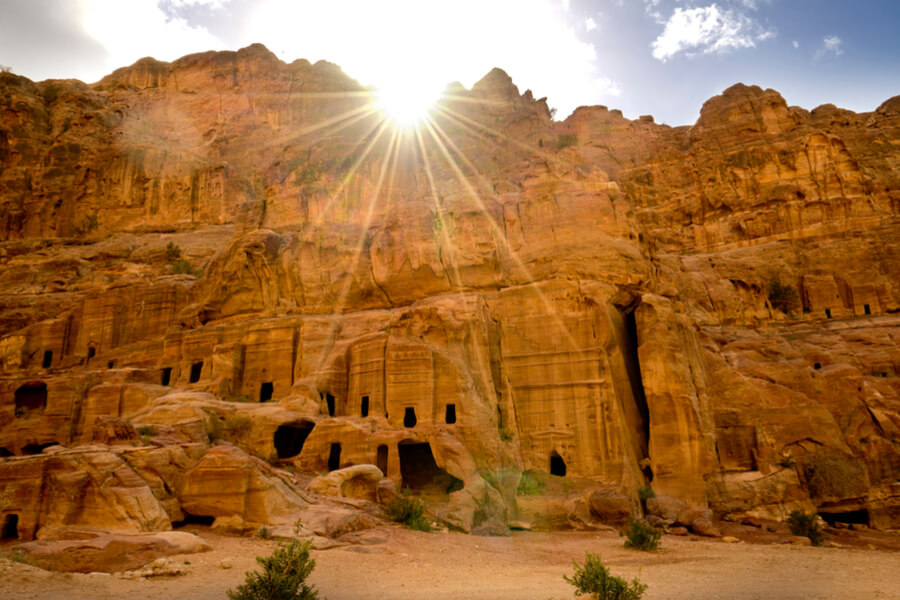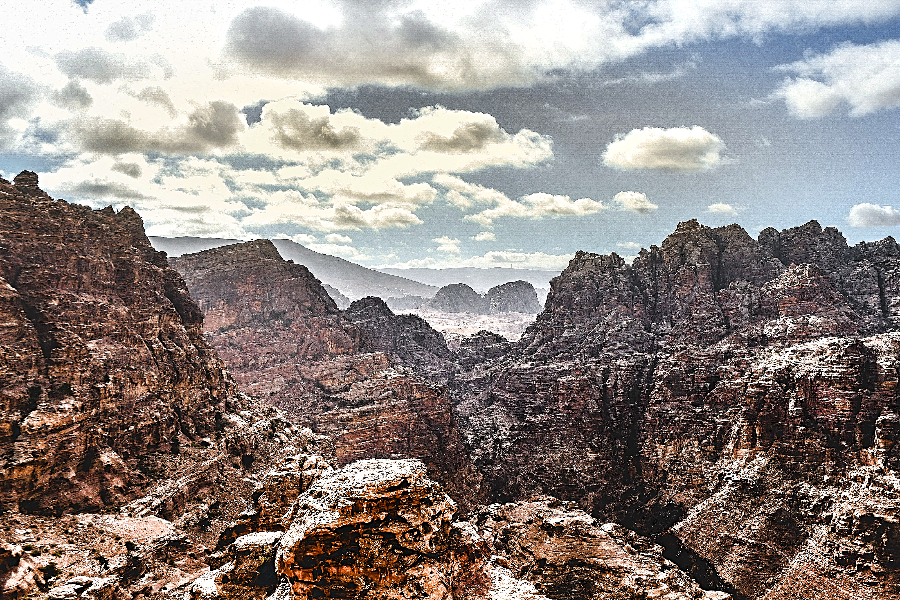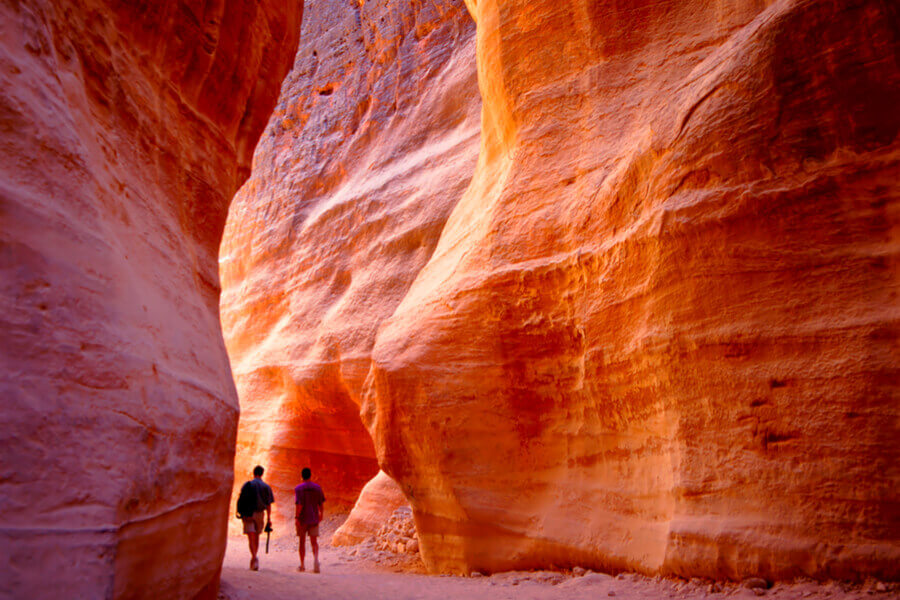Israel and Jordan Borders
Israel is a country with an enormous amount to see and do, and many tourists find that a week or two isn’t enough to do it justice. However, if you have the time and inlincation, we’d highly recommend a trip across the Israel-Jordan border, where you can visit Amman, the Wadi Rum desert and, of course, the magnificent ‘lost city’ of Petra. Built by the Nabateans in 312 BCE (making it one of the oldest cities in the world), it’s a fantastic attraction which few who see it ever forget.

Israel-Jordan Yitzhak Rabin/Araba Border Crossing. Photo credit: © Sarah Mann
Below, let’s take a look at the three border crossings between Israel and Jordan, along with plenty of practical information and helpful hints. If you’re thinking of crossing the border, hopefully, this short guide will enlighten you and make your journey relatively smooth and hassle-free...There are three border crossings between Jordan and Israel.
1. Jordan River / Sheikh Hussein / Beit Shean Crossing (North)
Located in the north of Israel, relatively close to the Sea of Galilee (in the Jordan Valley), this is perhaps the quietest of the three crossings. The Jordan River border crossing operates every day of the year, save for Yom Kippur (the Jewish Day of Atonement) and Eid al-Hijra (the Muslim New Year). On religious holidays, hours are subject to change - you can check this on the Israel Airports Authority (IAA) or call them at (972) 03 972-3333.
For almost every nationality, it is possible to acquire a visa for Jordan at this crossing (prior permission is not necessary). The border office is open on Sunday - Thursday: 06:30 - 22:00. Friday - Saturday: 09.00 - 20.00. 
Roman Theatre, Amman, Jordan. Photo credit: © Shutterstock
Travelling to the Sheikh Hussein Crossing
Superbus - the number 16 bus runs from Beit Shean and only costs 6 NIS (2 USD) but, unfortunately, does not go all the way to the crossing - it will drop you 1km away and you will either have to walk or take a taxi the remaining distance. Superbus can be reached at 1-700 700 181.
Nazarene Tours - This company runs coaches several times a week, beginning in Nazareth early in the morning and arriving in Amman around 2 pm. The approximate cost is 90 NIS (28 USD) one way. For a detailed timetable, click here.
Egged - Egged buses run to Beit Shean both from Jerusalem and Tel Aviv and the journey, in both cases, takes approximately 2 hours and costs around 50 NIS (16 USD). This is a great way to reach the southern edge of Israel. and get on a Petra Tour from Eilat.
Taxi - A private taxi from Beit Shean to the border (approx. 5 km) will take about 15 minutes. For the exact cost, call Oren Taxis at (972) 52 912-9606.
What about a rented car? It is not always possible to enter Jordan with your vehicle - we would recommend parking at the lot next to the terminal (a fee is payable).
Our advice: unless you have a good reason to cross here on your own, it might be easier to use one of the other two crossings (see below) since it is probably the least convenient and most costly way to travel between Israel and Jordan. If you'll take a Jordan Guided Tour, you'll also enjoy the convenience of border crossing arrangements and support.

Temple of Hercules in Amman, Jordan. Photo credit: © Shutterstock
Crossing Israel-Jordan Border over Sheikh Hussein and Heading to Amman
Once you have passed through the Israeli side and paid your exit fee (107 NIS, or 34 USD) you will need to take a shuttle bus (compulsory) a few hundred metres to the Jordanian side. The cost of this bus is 2 USD. When you exit the terminal, you will notice that you are more or less standing in the middle of nowhere and there is no public transport whatsoever on the Jordanian side.
Once you’ve come to grips with this, you have two options for getting to Amman. A taxi to the city of Irbid will cost about 20 JD, and from there, you can take a bus to Amman. Alternatively, a taxi directly to Amman may take less time, but it could get pricey since the driver will also realize that.
Whilst you are, at some level, a hostage to the taxi drivers there, don’t panic! A certain amount of negotiation is expected and it is in everyone’s interests that you take the cab, so don’t be afraid to bargain. A taxi to Irbid should cost around 20 Jordanian dinars ($30) and take an hour. To Amman, you should pay double, i.e. 40 JOD or $60 and it should take two hours.
Crossing Israel-Jordan Border over Sheikh Hussein with a Tour Guide
After paying your Israeli border tax, and crossing through passport control, take the shuttle (see above) to the Jordanian side. Please note: your passport must have at least 6 months' duration remaining. Any VAT tax refund for goods purchased in Israel must be claimed in the Israeli terminal.
Any individual with dual Israeli nationality must cross the border using their Israeli passport. At the Jordanian end, your English-speaking guide will be waiting for you, to give you any help you need. You will then be able to purchase your visa (approx 40 Jordanian dinars or 60 USD). There is a money exchange on site.

Amman, Jordan. Photo by Stefanos Orovas on Unsplash
2. Yitzhak Rabin / Wadi Araba Crossing (South)
Located in the far south of Israel, 325 km from Amman, the Wadi Araba border crossing sits on the Red Sea and connects the two resort towns of Eilat and Aqaba. Normal Operating Hours: Sunday - Thursday: 06:30 - 20,00. Friday - Saturday: 08.00 - 20.00.
Like the Sheikh Hussein crossing, in the north of the country, this border is also closed on Yom Kippur and the Muslim New Year. Also, as above, on religious holidays, hours are subject to change - (check with the Israel Airports Authority) and it is, for the most part, easy to purchase a visa at this crossing.
The exit fee on the Israeli side is 107 NIS (33,5 USD) and should be paid either in shekels or dollars. This crossing has free parking, a currency exchange booth, and vending machines and is accessible for disabled people. Due to the pandemic, this crossing is operating with limited opening hours and closes each afternoon at 1 pm. This means day tours of Petra are currently unavailable.
It is possible to purchase an entry visa for Jordan at this border (see above, the cost being the same as at the Beit Shean crossing). Worth noting is that the longer you stay in Jordan, the less you will pay when departing this country (presumably this is to encourage people to stay longer than a day trip). If you arrive and depart from Aqaba, and have stayed more than 3 nights in the country, your exit tax of 10 JOD will be waived.

View of Amman, Jordan. Photo by Ayman Yusuf on Unsplash
Taking a Group Tour to Petra
If you travel as part of organised Israel and Jordan tours, your entry documents will be organised by the company and guide. Without a doubt, if you want to travel to Petra, then you should use this crossing. You are far more likely to have a shorter waiting time and journeying to Aqaba, across from Israel’s Eilat - takes only 10 minutes, with Petra being another 2-hour drive. The organized tour option is the most convenient for most tourists, and many like to take a Jerusalem to Petra Tour or a Petra Tour from Tel Aviv.
Travelling to the Yitzach Rabin Border Independently
If you are driving, it is a long, straight road south to Eilat from the centre (about 4 hours drive from Tel Aviv/Jerusalem) and it is possible to park your car in the free parking terminal at the border. Egged buses also run regularly from major cities to the south and once you are at the bus station, either you can take buses that travel regularly from Jerusalem and Tel Aviv to Eilat and once you have arrived at the bus station, you can either take a taxi to the border or a public bus.
Quotes of 50 ILS ($15) from taxi drivers can usually be bargained down to 35 NIS ($10). It is a short ride, but the best you can do is try to bargain him down to 25-35 ILS (7.5-11 USD). If you want to save money, take the public bus (which leaves every hour and costs 4 NIS) and ask for the Eliot stop. The only problem is that you’ll then have to walk about 1.5 km further along, and in the summer when temperatures can soar way past 42 degrees (109F) this may completely exhaust you. If you rented a car, you can drive directly to the border terminal, where there is a free parking lot.
The Siq, is the entrance to the City of Petra. Photo credit: © Shutterstock
Crossing Israel-Jordan Border at Yitzhak Rabin/Araba
The actual crossing is usually quite fast and comfortable and whilst the terminal is not renovated, or air-conditioned, it usually takes no more than 30 minutes to half an hour. As before, you need to pay your exit tax but then you can simply keep walking (it’s a two minutes walk). On the Jordanian side, you can purchase your visa (if you don’t have one) and then head-on.
Most people are heading to Petra and the first city that you have to pass through is Aqaba. If you’re not travelling as part of a tour to Jordan (i.e. on a coach) you’ll have to face the ‘taxi mafia’ to make the 12-minute ride to Aqaba, since there are no public buses. This can be amusing, irritating or downright infuriating, depending on your experience!
Essentially, cab drivers there are trying to make as much money as they can since you are a ‘captive audience’. It is quite common if you try to get into a taxi with one or two people you’ve met at the crossing, the taxi drivers will shake their heads and tell you you can only travel with people you know. This way, they get more fares! The smartest way to deal with this is to arrange who you want to ‘taxi pool’ with before you come out into the parking lot, and insist to the cab driver that you are a group. Good luck!
Cost of a Taxi to Petra or Aqaba
Taking a taxi directly to Petra is probably the quickest and most convenient way to travel on your own but it will cost you - around 50-55 Jordanian dinars ($70-$75). Alternatively, you can take a taxi to Aqaba (approx. 10 JOD or 15 USD - although you should bargain!) and then hire a taxi for a cheaper price (around 30 JODs/ 42 USD).
If you have time, want to save some cash and are adventurous, you can also take the public minibuses, which leave from the downtown bus station there. They run from 6 am onwards, hold 10 people and only leave when the bus is full, so you might have to wait a bit. However, the cost is only 5 JOD ($7.5) and you’ll get to meet a few people too! Two hours later, ‘inshallah’ (’as God wills it) as they say in Arabic, you will have arrived in Petra.

The Treasury, Petra, Jordan. Photo credit: © Shutterstock
3. Allenby Bridge/King Hussein Bridge Crossing (Center)
The Allenby Bridge border (named after a British commander during the time of the Mandate) lies between the first two borders (see above) and is situated on the Jordan River, about 5 km from Jericho and close to the Dead Sea. About an hour’s drive from Jerusalem (57 km) and another hour’s drive from Amman (53 km), this border crossing is situated in the south of the Jordan Valley. It is important to note that this crossing is only available for foreign tourists, diplomats and some Palestinians. Those who have Israeli citizenship can not cross into Jordan from here.
Normal Operating Hours: Sunday - Thursday: 07:30 - 24.00. Friday: 07.30 - 15.00. Saturday: 07.30 - 15.00. The terminal has a currency exchange booth, a cafeteria and restaurant, a section where you can buy insurance and a VAT refund area. It is also wheelchair friendly.
From Israel into Jordan
The most important thing to know, in advance, is that if you are trying to cross into Jordan using this border crossing, you will NOT be able to purchase a visa here. You must apply for a visa at a Jordanian consulate beforehand (either in Jerusalem or Tel Aviv) and should allow anywhere between 3-10 days before it is processed.
The most important thing to know before trying to cross into Jordan via the King Hussein Bridge, and perhaps the biggest drawback, is that Jordan does not issue visas at this border. You must apply for a visa at a Jordanian consulate beforehand, and it can take anywhere from 2-15 days to receive it. For more details, contact Jordanian consular services.
The second thing to know is that this is the crossing at which you will probably wait the longest to pass. Many Palestinians from the West Bank, who wish to travel internationally, use this route to access the airport in Amman and as well as the high volume of traffic, there are strict security checks.

Royal Tombs, Petra. Photo credit: © Shutterstock
Travelling to the Allenby Bridge from Jerusalem
If you are travelling as an individual you can either take a private taxi (approximately 400 NIS / 125 USD), a yellow taxi van from the Damascus Gate Bus Station in East Jerusalem (approx. 20 NIS) or an Egged bus 961 (approx 20 NIS / 6,5 USD). Please note that the Egged bus (like the other crossings) will not drop you directly at the crossing - it’s a 2 km walk from the bus stop.
After showing your passport and paying an exit tax of 107 NIS (33,5 USD), you will need to take a 15-minute bus ride to the Jordanian side. This bus costs 5 JOD and 1.5 JOD per bag. The buses can be sporadic, so make sure you are not in a rush. After passing through customs, you can either take a minibus to Abdali Station in Amman (7 JOD or 11 USD) or a private taxi (approximately 50-55 Jordanian dinars or 70-75 USD).
Crossing the Allenby Bridge back into Israel
Visas (if necessary) must be obtained from the Jordanian Embassy in Amman, before crossing here and private cars and tour buses cannot cross here - you will be required to change vehicles. Depending on how long you have stayed in Jordan, you will have to pay an exit tax when crossing the border from Jordan to Israel. If you have stayed more than 3 nights, it will be waived.

Wadi Rum desert. Photo by Karam Hamadneh on Unsplash
Tips for the Crossing
If you’ve already read the above, you’ll quickly realise that public transport at the northern and southern crossings, on the Jordanian side, is pretty limited. This is why many people decide to take organised tours of Petra and Jordan or travel to Jordan within the framework of your Israel and Jordan tour package - it will save you a great deal of hassle.
We recommend that you wear comfortable footwear whilst in Jordan (particularly when hiking in Wadi Rum or Petra) and as it is a Muslim country (albeit not overly so) dress modestly. Women should aim to cover their shoulders and knees (no spaghetti tops or tight T-shirts). Drink plenty of fluids in the spring and summer months, as it is incredibly hot. We recommend not drinking water from the tap, but rather buying it in sealed bottles (which are easily available throughout the country).
COVID-19 Update
As of August 2021, travelling across the Israel-Jordan border is still relatively challenging, because of the COVID-19 pandemic. The southern border, between Eilat and Aqaba, has re-opened but has restricted hours, with early afternoon closing. A review of this is planned for some time later in the summer.
Insofar as the Beit Shean and Allenby Bridge borders are concerned, there is no concrete information as to when they will reopen since a rising infection rate means that tourists are still not able to enter Israel. As soon as Bein Harim begins receiving incoming groups, we hope to resume our regular tours to Jordan but, at this point, we do not know when this will be.

Mountains around Petra, Jordan. Photo by Sam Power on Unsplash
 Login / Register
Login / Register
 Contact Us
Contact Us

 Certificate of Excellence
Certificate of Excellence Guaranteed Departure
Guaranteed Departure Low Prices Guaranteed
Low Prices Guaranteed 24/7 Support
24/7 Support




